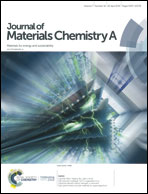Binary organic spacer-based quasi-two-dimensional perovskites with preferable vertical orientation and efficient charge transport for high-performance planar solar cells†
Abstract
Quasi-two-dimensional (Q-2D) perovskites ((RNH3)2MAn−1PbnI3n+1, RNH3 represents the organic spacer (mostly phenethylammonium (PEA) and n-butylammonium (BA)) and MA = methylammonium) have shown great potential for application in solar cells due to their intrinsic stability, where the organic spacer dominantly determines the Q-2D perovskite ambient stability and device performance. Current studies merely concentrate on unary organic spacer Q-2D perovskites, either using BA or PEA. Herein, for the first time, we have successfully designed and fabricated (PEA1−xBAx)2MA3Pb4I13 binary spacer-based Q-2D perovskite films, and demonstrated that the device using binary organic spacer-based Q-2D perovskite films has substantially better performance than that using either of the unary organic spacer-based Q-2D perovskite films. The (PEA0.8BA0.2)2MA3Pb4I13 binary spacer device yields a maximum power conversion efficiency of 15.7%, which outperforms the efficiency record (12–14%) for unary spacer (PEA or BA) Q-2D perovskite devices. In particular, a peak open-circuit voltage of 1.21 V is achieved due to a non-radiative recombination loss of ∼100 mV, the lowest reported loss value for Q-2D perovskite devices. The high device performance results from binary-spacer-induced intensified film surface quality, preferable vertical orientation of crystals and improved film optoelectronic properties as well as obviously decreased device recombination losses. These findings open up a new avenue for the rational design of Q-2D perovskite materials with polynary organic spacer.



 Please wait while we load your content...
Please wait while we load your content...